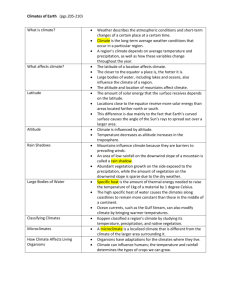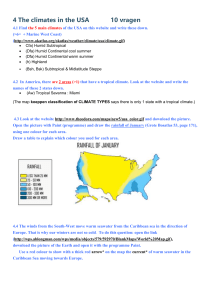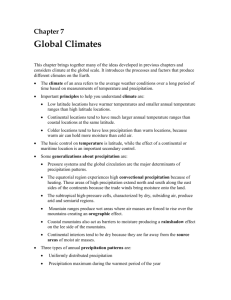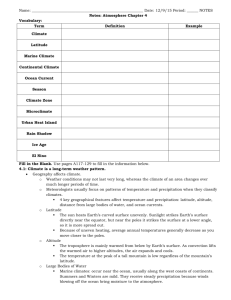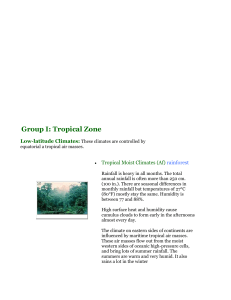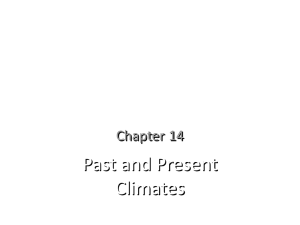Tropical Deserts
advertisement
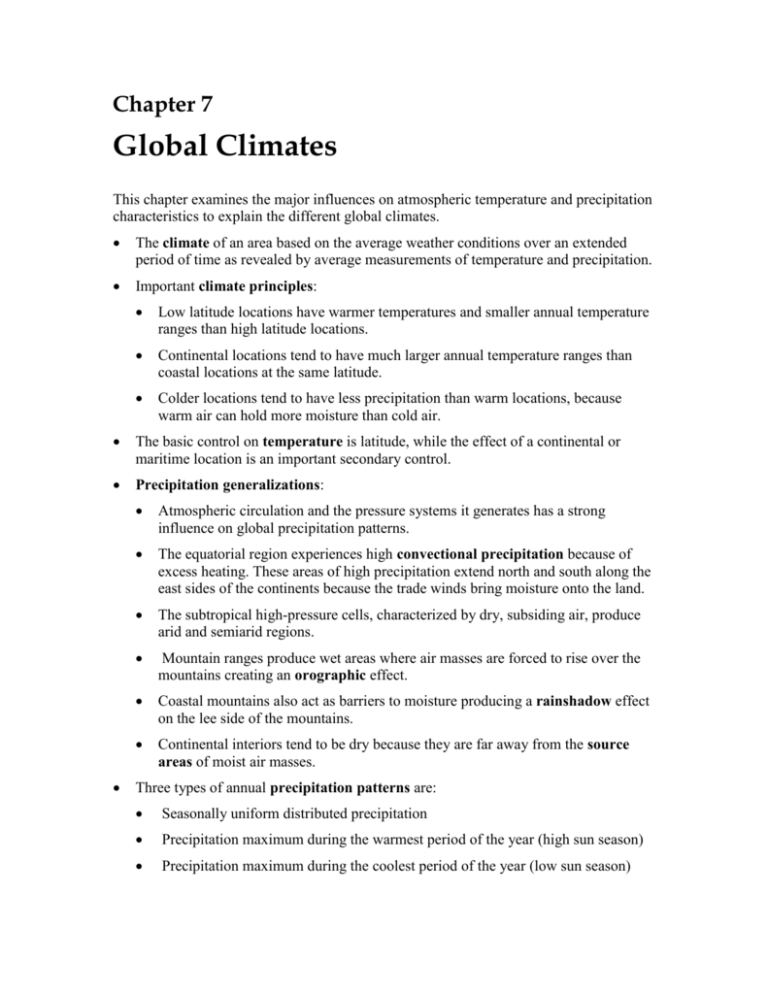
Chapter 7 Global Climates This chapter examines the major influences on atmospheric temperature and precipitation characteristics to explain the different global climates. The climate of an area based on the average weather conditions over an extended period of time as revealed by average measurements of temperature and precipitation. Important climate principles: Low latitude locations have warmer temperatures and smaller annual temperature ranges than high latitude locations. Continental locations tend to have much larger annual temperature ranges than coastal locations at the same latitude. Colder locations tend to have less precipitation than warm locations, because warm air can hold more moisture than cold air. The basic control on temperature is latitude, while the effect of a continental or maritime location is an important secondary control. Precipitation generalizations: Atmospheric circulation and the pressure systems it generates has a strong influence on global precipitation patterns. The equatorial region experiences high convectional precipitation because of excess heating. These areas of high precipitation extend north and south along the east sides of the continents because the trade winds bring moisture onto the land. The subtropical high-pressure cells, characterized by dry, subsiding air, produce arid and semiarid regions. Mountain ranges produce wet areas where air masses are forced to rise over the mountains creating an orographic effect. Coastal mountains also act as barriers to moisture producing a rainshadow effect on the lee side of the mountains. Continental interiors tend to be dry because they are far away from the source areas of moist air masses. Three types of annual precipitation patterns are: Seasonally uniform distributed precipitation Precipitation maximum during the warmest period of the year (high sun season) Precipitation maximum during the coolest period of the year (low sun season) Seven global precipitation regions: Wet equatorial Trade wind coasts Tropical Deserts Midlatitude deserts and steppes Moist subtropical Midlatitude west coasts Arctic and Polar Deserts Low latitude climates are dominated by cT, mT, and mE air masses. The position of the ITCZ and the subtropical high pressure cell affect these climates throughout the year. Weather disturbances include the easterly wave and tropical cyclones. This group of climates includes: Wet equatorial Monsoon and trade-wind coast Wet-dry tropical Dry tropical Midlatitude climates occupy the polar front zone where warm and cold air masses interact producing wave cyclones. This groups of climates includes: Dry subtropical Moist subtropical Mediterranean Marine west-coast Dry midlatitude Moist continental High latitude climates are dominated by polar and arctic air masses. They are sources areas of cP, mP, cA, and cAA air masses. Continental polar air meets cA air along the arctic front zone. This group of climates includes: Boreal forest Tundra Ice Sheet Dry climates are those in which the potential total annual evaporation greatly exceeds the annual precipitation amount. Low latitude climates: occupy the equatorial zone, much of the tropical zone, and some of the subtropical zone include climates that range from very wet to very dry are influenced by the intertropical convergence zone (ITCZ), tropical easterly wind systems, and the subtropical high pressure cells experience traveling low pressure systems such as the easterly wave and tropical cyclones The wet equatorial climate is characterized by: a dominance of the intertropical convergence zone (ITCZ) mE and mT air masses uniform, very warm temperatures in all seasons ample precipitation, heaviest when the ITC is nearby Monsoon and trade wind coastal climates are characterized by: heavy rainfall with strong seasonal patterns a larger temperature range than the wet equatorial climate adominance of the ITCZ during the heavy rainfall period and the subtropical high pressure system during the dry season trade wind coast climates that are a result of mT and mE air masses blowing onto coastal areas and bringing large amounts of moisture monsoons which are a result of the changing position of the ITC and reversing pressure gradients heavy rainfall associated with the ITCZ and an airflow from ocean to land surfaces, while the dry season is associated with airflow off the Asian continent to the ocean The wet equatorial, monsoon, and trade wind coastal climates produce low latitude rainforests with dense vegetation, numerous streams, and a great diversity of plant and animal life. The wet-dry tropical climate is characterized by: a warm climate with a distinct temperature range a high sun season proximity to the ITCZ resulting in heavy rains a low sun season proximity to the subtropical high pressure cell resulting in very dry conditions vegetation described as rain-green since it is adapted to the seasonality of rainfall (it enters a dormant period during the dry season and leafs out and blooms in the rainy season) dramatic variations in rainfall which are reflected in streamflows that vary from very low to flood-like conditions agriculture experiencing periodic drought The dry tropical climate: is dominated by the Subtropical High Pressure Cell experiences very low precipitation and intense daytime heating under predominantly clear skies includes many of the world's great deserts includes semi-arid areas on the edges of the desert may have a short wet season (steppe areas are transitional from the desert to the wet-dry tropical climate) Midlatitude and high latitude climates as a group: occupy the midlatitude zone, part of the subtropical zone, and extend poleward into the subarctic latitude zone are located mainly in the northern hemisphere are affected by the poleward portion of the subtropical high pressure cells, the westerly wind belt, and the conflict between warm and cold air masses that occurs along the polar front zone The dry subtropical climate: is a poleward extension of the dry tropical climate but shows a greater annual temperature range due to its higher latitude experiences a cool or cold (low sun) season influenced by invasions of air from higher latitudes receives occasional precipitation from midlatitude cyclones is divided into arid and semi-arid subtypes has more abundant vegetation than the dry tropical climate due to lower temperatures and slightly more precipitation supports plants and animals that have adapted their life cycles to take advantage of infrequent periods of rain only supports irrigated agriculture The moist subtropical climate: is created by warm, moist air flowing out of the subtropical high pressure cells onto the eastern sides of the continents has abundant summer rainfall which is mainly convectional with an occasional tropical cyclone experiences a strong monsoon effect in Southeast Asia receives winter precipitation from wave cyclones while the storm tracks are in their most southerly position has abundant yearly precipitation which provides ample water for urban and industrial development but may cause flooding supports broadleaf deciduous and evergreen forests and some needle-leaf and pine forests soils are depleted by high rainfall as nutrients are washed out of the soil The Mediterranean climate: experiences a very dry summer due to migration of the subtropical high-pressure cell into the area winter is dominated by rainfall provided by cP air masses and cyclonic storms has a moderate temperature range is limited to narrow coastal zones is a pleasant climate for humans although there are problems with water availability in summer and plants must adapt to the dry summer period The marine west coast climate: experiences mild temperatures with a small temperature range for its latitude is a moist climate with a winter precipitation maximum due to frequent cyclonic storms (in summer the northward movement of the subtropical high pressure cell reduces precipitation) supports needle-leaf forests in the wet mountainous areas of Pacific North America and deciduous trees in relatively drier areas in Europe The dry midlatitude climate: influences the interior regions of North America and Eurasia in some areas, experiences a rainshadow effect which blocks maritime air masses and allows drier continental air masses to dominate experiences convectional summer rainfall associated with occasional maritime air masses has a strong annual temperature range with warm to hot summers and cold to very cold winters includes arid and semi-arid environments ranging from cold desert to steppes soils have a high natural fertility and support a vegetation of short grass prairie with moisture being the limiting factor experienced serious land degradation during the drought years of the 1930s after vast areas of land in this climate type were broken for agriculture The moist continental climate: is found in central and eastern North America and Eurasia exhibits large seasonal temperature variations as well as strong day-to-day variations receives ample precipitation peaking in the summer under the influence of mT air masses while the winter is dominated by cP and cA air masses experiences a monsoon effect which increases summer precipitation in East Asia supports a native vegetation of deciduous forest which grades into tall grass prairie toward continental interiors soils show some leaching and acidity due to an abundance of precipitation supports large scale agriculture The high latitude climates: are influenced by mP air masses conflicting with cP and cA air masses and wave cyclones which develop along the arctic-front zone experience higher summer precipitation brought in by mT air masses The boreal forest climate: has long, bitterly cold winters and short cool summers experiences a very large annual temperature range as a result of its continental location is a source region for cP air masses (invasions of cA air masses are common) has low total annual precipitation with a summer precipitation maximum produced by maritime air masses The tundra climate: is found along arctic coastal areas experiences long severe winters dominated by cP, mP, and cA air masses has a smaller temperature range than expected for its latitude due to the moderating effect of the nearby marine environment vegetation consists of grasses, sedges, lichens, and some shrubs; species diversity is low but the number of individuals is high soils are poorly developed and are underlain with permafrost Permafrost is permanently frozen ground overlain by an active layer that thaws during the summer. The tundra climate is cold enough to create continuous permafrost, frozen ground with few gaps or interruptions. Discontinuous permafrost occurs in patches and is found in the boreal forest climate. The ice sheet climate: is the source region of Arctic and Antarctic air masses occurs on the ice sheets of Greenland and Antarctica and over the Arctic ocean ice experiences the lowest mean annual temperature; no month has a mean temperature above freezing is a very harsh environment devoid of soils and vegetation, and the few species of animals found in this climate are marine oriented

